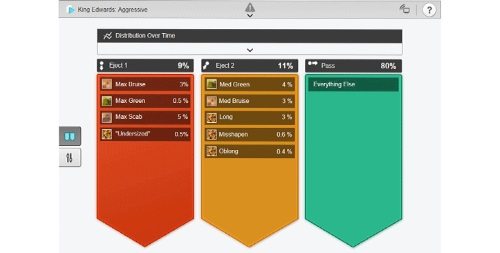In the past decade consumers have become more demanding about the produce they buy, claiming better, more consistent quality and size in the pack.
Optical sorting technology has developed at a rapid rate to react to this demand.
This resulted in highly sophisticated sorting machines like the Tomra Halo with advanced functionalities for a flexible and refined sort of the incoming crop, producing primary and secondary marketable pack and process grades.
Such requirements become more complex and with possible multiple varieties of potatoes washed and packed or processed daily, the job for the user controlling the sorter has become more challenging.
Making the connection between the sorter settings and the final product result is now vital to optimize the use of the incoming potatoes.
New interface
The company’s new interface is designed for the user or operator to makes sorting adjustments simple and predictable enabling full control.
This is achieved by changing the way the defect and product features are setup.
Each user can define their own sorting criteria and name them the way they want it.
Typically defects of different intensity and size will be setup in different ‘feature boxes’ for critical or minor defects such as green and brown.
This removes the fear of the operator changing settings because they have set, saved and named them, themselves in the system database.
“The user is now really in control of the defects,” says Jim Frost, market unit manager whole products sorting at Tomra Sorting Food.
In addition, operators can combine size of the product and color defect levels to manipulate the sort of the potatoes in order to recover more.
“Operators will be able to set up a combined sort such as combining a small defect (color) on a small potato (length) as waste, but that same small defect (color) on a bigger potato (length) is still within the grade,” says Frost.
“Instead of having settings for every defect separately we are now combining them making the Halo sorter more intelligent. The operator can now convert a potato which used to be classified as waste into one which can still be used as a marketable ‘grade’.”
The user interface has a touchscreen ‘drag and drop’ feature which within seconds, allows the customer to decide, set and then clearly see which quality of potatoes goes to what sort exit.
To control the sort efficiently, the user needs feedback about the potatoes from the sorter, which is provided with ‘at a glance’ dashboard on screen displays of product and machine data.
Product data will include size and defect profiles of the product sorted.
These data sets will also be available for supervisory control and data acquisition or SCADA or transfer to the plant servers for analysis and traceability.










